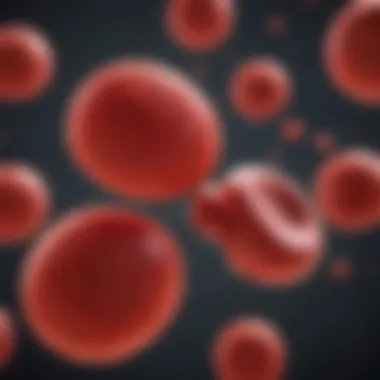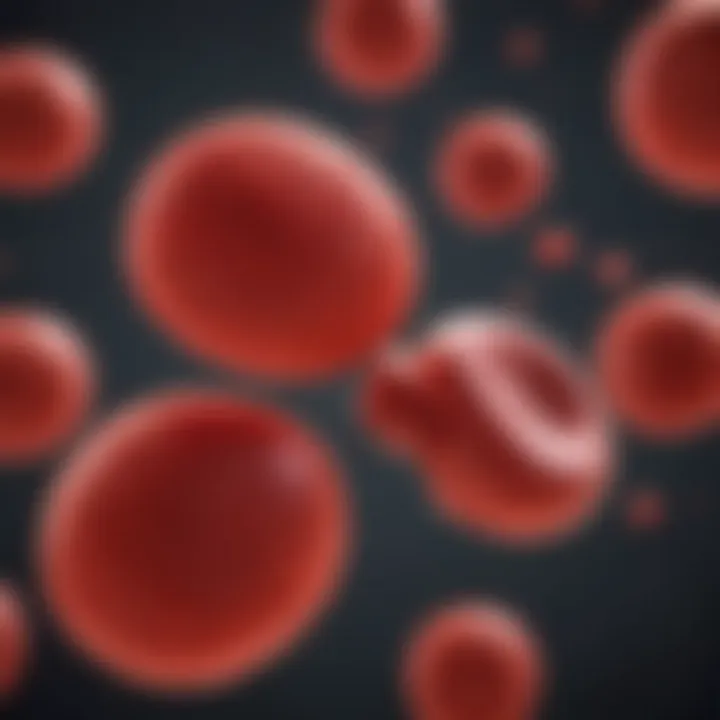Understanding Sickle Cell Disease: Key Insights and Advances


Intro
Sickle cell disease (SCD) is a genetic disorder with significant implications for human health. It alters hemoglobin, the protein in red blood cells responsible for transporting oxygen throughout the body. This disorder leads to sickle-shaped cells that can cause numerous complications, including severe pain and organ damage. Understanding the intricacies of SCD is essential for those involved in healthcare and research, as well as for affected individuals and their families.
This article will provide a systematic review of various aspects surrounding sickle cell disease. By exploring the etiology, pathophysiology, symptoms, diagnosis, and available treatments, readers will gain insight into the challenges faced by patients. Moreover, ongoing research efforts aimed at improvement of management strategies will be discussed, emphasizing the continuous need for innovation in this field.
In presenting this comprehensive overview, we aim to highlight key points relevant to the understanding of sickle cell disease while ensuring that the information is accessible and informative for students, researchers, educators, and professionals in the healthcare domain.
Prelims to Sickle Cell Disease
Sickle cell disease is a prevalent genetic disorder that significantly affects individuals' lives globally. Its impact is not only medical but also deeply social and economic. Understanding the nuances of this condition is paramount for healthcare providers, researchers, and those engaged in patient care. This article aims to provide a comprehensive examination of sickle cell disease by exploring its etiology, pathophysiology, clinical manifestations, and management strategies.
Why the Topic is Important
Sickle cell disease involves severe complications that can lead to a decreased quality of life. Knowledge about this condition allows caregivers and healthcare professionals to provide better assistance to patients. It facilitates early diagnosis and appropriate interventions. Education around sickle cell disease also helps raise awareness, which can lead to increased funding for research and treatment options.
Sickle cell disease arises from a single mutation in the hemoglobin gene, resulting in altered red blood cell shape. The abnormal sickled cells create blockages in small blood vessels, causing pain episodes and possibly severe health complications. Consequently, the implications extend far beyond the individual, affecting families and communities. The multifactorial aspects of sickle cell disease encompass genetics, healthcare access, and socioeconomic factors.
Furthermore, ongoing advancements in treatment and research are vital. These developments can change how the disease is managed and offer hope for those affected. A comprehensive overview of sickle cell disease introduces these critical discussions, emphasizing the need for collaborative efforts among researchers, healthcare practitioners, and patients.
"Understanding sickle cell disease is not just a medical necessity; it is a societal obligation that calls for compassion and continuous inquiry."
Several strategies exist for managing sickle cell disease, each aimed at reducing symptoms and improving patient health outcomes. It is essential to engage in discussions surrounding genetic counseling, patient lifestyle modifications, and advancements in therapeutic interventions. By exploring these aspects thoroughly, we can better understand and address the needs of those living with sickle cell disease.
Genetic Basis of Sickle Cell Disease
The genetic basis of sickle cell disease is a critical aspect of understanding the condition itself. This disorder stems from a specific mutation in the HBB gene, which encodes for the beta-globin subunit of hemoglobin. Hemoglobin is responsible for transporting oxygen in red blood cells. Knowing the genetic underpinnings helps in explaining how the disease is inherited and its manifestations in the body.
Understanding these elements aids in genetic counseling, which is pivotal for families at risk. As sickle cell disease follows a clear genetic pattern, educating patients and their families on inheritance is essential for informed health decisions and management strategies.
Inheritance Patterns
Sickle cell disease follows an autosomal recessive inheritance pattern. This means a child must inherit two copies of the mutated gene, one from each parent, to exhibit the disease. If a person inherits only one mutated copy, they become a carrier and typically do not show symptoms themselves. Carriers are said to have sickle cell trait, which can be crucial information for family planning.
Key Points on Inheritance Patterns:
- Autosomal Recessive: Requires both parents to pass on the mutated gene.
- Carrier Status: Individuals with one mutated allele often remain asymptomatic but can pass the trait to offspring.
- Risk Assessment: Genetic testing can identify carriers, allowing for informed reproductive choices.
Recognizing these patterns enables healthcare providers to predict the likelihood of sickle cell disease in future generations, which is vital for improving patient outcomes.
Mutation in HBB Gene
The specific mutation associated with sickle cell disease occurs in the HBB gene, which is located on chromosome 11. This mutation results in the substitution of valine for glutamic acid at the sixth position of the beta-globin chain. This single amino acid change alters the properties of hemoglobin, transforming it into hemoglobin S (HbS).
When oxygen levels are low, HbS molecules stick together, causing red blood cells to deform into a characteristic sickle shape.
Points of Interest about HBB Gene Mutation:
- Single Point Mutation: A single nucleotide change has significant physiological effects.
- Deformation of Red Blood Cells: Sickle-shaped cells lead to blockages in blood vessels, causing pain and other complications.
- Severity Variation: The extent of the disease can vary based on the amount of HbS produced versus normal hemoglobin (HbA).
Understanding the mutation in the HBB gene is paramount for developing therapies, such as gene therapy, which aim to correct this defect.
"The genetic understanding of sickle cell disease opens doors for innovative treatments and improved patient management strategies."
In summary, the genetic basis of sickle cell disease highlights how critical genetic information is for patient care. By exploring inheritance patterns and the specific HBB gene mutation, we establish a foundation for understanding the disease’s impact on individuals and families.
Pathophysiology of Sickle Cell Disease
The pathophysiology of sickle cell disease plays a crucial role in understanding this complex condition. It entails insight into how the abnormal hemoglobin affects red blood cells, ultimately leading to the symptoms and complications associated with the disease. This section dissects the core elements, demonstrating how the molecular alterations in hemoglobin translate to clinical manifestations in patients.
Abnormal Hemoglobin Structure
The hallmark of sickle cell disease is the presence of a variant of hemoglobin known as hemoglobin S. This mutation occurs in the HBB gene, which encodes the beta-globin subunit of hemoglobin. In a normal scenario, hemoglobin A (the typical adult hemoglobin) is made up of two alpha and two beta chains. In sickle cell disease, the substitution of valine for glutamic acid at the sixth position of the beta-globin chain leads to structural changes. This single amino acid substitution causes the hemoglobin molecules to polymerize when deoxygenated, which distorts the red blood cells into a characteristic sickle shape.
The resulting sickle shape significantly impacts the function and lifespan of the red blood cells. Unlike healthy red blood cells, which are flexible and can easily navigate through small blood vessels, sickled cells become rigid and sticky. This abnormality causes increased hemolysis, where the cells rupture prematurely, leading to anemia. Moreover, the misshapen cells tend to clump together, blocking blood flow in capillaries and leading to painful vaso-occlusive crises.
Red Blood Cell Deformity
The deformity of red blood cells in sickle cell disease is central to its pathophysiology and has several clinical implications. Sickle-shaped cells struggle to pass through capillaries. This can cause a range of complications due to disrupted blood supply to tissues. When circulation is impaired, organs are deprived of oxygen, resulting in pain, organ damage, and an increased risk of infections. The chronic nature of anoxia can lead to complications such as acute chest syndrome, which is a severe lung-related condition.
Additionally, red blood cell deformity also affects the body's ability to regulate blood flow. For example, splenic sequestration occurs when sickled cells accumulate in the spleen, drastically reducing its function. This increased destruction of red blood cells is a significant factor in the disease.


The analysis of the pathophysiology of sickle cell disease reveals how molecular and structural changes translate into systemic complications. Understanding these mechanisms is vital for creating effective treatment strategies.
By spotlighting the pathophysiological mechanisms, healthcare professionals can better tailor management and treatment strategies for individuals with sickle cell disease. Consequently, such knowledge is instrumental in advancing research and improving outcomes for affected patients.
Clinical Manifestations
The clinical manifestations of sickle cell disease play a pivotal role in understanding how the condition affects patients. Knowing these manifestations allows clinicians, patients, and caregivers to anticipate complications, provide timely treatment, and improve overall quality of life. The symptoms of sickle cell disease do not only impact the physical health of an individual but also intertwine with their emotional and social well-being. This section offers insights into the common symptoms experienced by patients and the surgeries and interventions that can arise from complications associated with the disease.
Common Symptoms
Patients with sickle cell disease may present various symptoms, which can vary significantly in intensity and duration among individuals. While symptoms can be diverse, some common manifestations include:
- Anemia: Chronic anemia occurs due to the rapid destruction of sickled red blood cells. Patients often feel fatigued and weak.
- Pain Episodes: Known as sickle cell crises, these periods of severe pain can occur unexpectedly, often in the chest, abdomen, or joints.
- Swelling: Painful swelling, especially of the hands and feet, is termed dactylitis and is often one of the earliest signs in infants.
- Jaundice: Yellowing of the skin and eyes due to increased bilirubin levels from the breakdown of red blood cells.
- Frequent Infections: Impaired spleen function leads to increased susceptibility to infections, making vaccinations crucial for these patients.
It is essential for healthcare providers to develop treatment plans based on these symptoms. Regular monitoring and proactive management can help mitigate the severity of these common symptoms.
Complications of Sickle Cell Disease
Sickle cell disease can lead to severe complications that can threaten the lives of patients. Recognizing and managing these complications is critical. Some understandings include:
- Acute Chest Syndrome: A life-threatening condition marked by chest pain, fever, and lung infiltrates; requires urgent care.
- Stroke: Blockages in blood flow to the brain can result in strokes, necessitating immediate intervention.
- Organ Damage: Long-term effects of sickle cell disease can impair the function of organs such as the liver, kidneys, and heart.
- Leg Ulcers: Chronic wounds can develop, often requiring careful wound care and possibly surgical intervention.
"Timely recognition and management of complications improve survival and quality of life in sickle cell disease patients."
A tailored approach that incorporates these clinical manifestations into treatment strategies can alleviate suffering and improve health outcomes for those affected. The advancement of therapies and research is essential to address the complexities of these manifestations, making ongoing education for healthcare teams and patients a priority.
Diagnosis of Sickle Cell Disease
Diagnosis plays a critical role in managing sickle cell disease effectively. Early detection can significantly improve patient outcomes, guiding treatment decisions and helping to prevent complications. Healthcare systems increasingly rely on systematic screening protocols and innovative laboratory tests to make accurate and timely diagnoses.
Newborn Screening Protocols
Newborn screening for sickle cell disease is a primary strategy undertaken in many countries. It aims to identify infants who carry the sickle cell trait or have the disease itself at an early age. This procedure is crucial because interventions can begin immediately, reducing the risk of severe complications.
In most cases, testing involves a heel prick to collect blood samples. These samples undergo analysis to detect abnormal hemoglobin types. The HPLC (High-Performance Liquid Chromatography) method is commonly used in laboratories to quantify different types of hemoglobin. Newborn screening programs have allowed successful treatment interventions, including prophylactic penicillin in neonates, which are shown to lower infection risks.
"Early diagnosis through newborn screening can drastically alter the life trajectory of children with sickle cell disease, enhancing quality of life and survival rates."
Laboratory Tests and Imaging
Beyond newborn screening, various laboratory tests are conducted to diagnose sickle cell disease in older children and adults. Complete blood counts (CBC) reveal important data about red blood cell counts and anemia. The presence of sickle-shaped cells can also be identified through a blood smear. This manual examination allows for the visualization of deformities in red blood cells, confirming the disease.
Furthermore, imaging studies may aid in understanding complications arising from sickle cell disease. Regular monitoring through ultrasound can be vital for detecting conditions such as splenic sequestration or stroke. Magnetic Resonance Imaging (MRI) may also be used to assess damage to vital organs caused by compromised blood flow.
In summary, both newborn screening and subsequent laboratory tests are essential components in diagnosing sickle cell disease. These methods ensure that individuals affected by the condition receive appropriate management and avoid severe lifelong complications. These approaches also underline the complexity and necessity of a multidimensional diagnostic strategy.
Management Strategies
Effective management of sickle cell disease is critical. By utilizing appropriate strategies, healthcare providers can improve patient outcomes and enhance the quality of life for those affected. Management strategies encompass a combination of pharmacologic treatments and non-pharmacological approaches aimed at alleviating symptoms and preventing complications. In understanding these strategies, it is important to consider their benefits, limitations, and the physical and psychosocial welfare of the patients.
Pharmacologic Treatment
Pharmacologic treatment is a cornerstone in the management of sickle cell disease. Medications play a vital role in reducing the frequency and severity of crises. Some key areas of focus include:
- Hydroxyurea: This medication helps to increase fetal hemoglobin levels, which can reduce the number of painful crises. It may also reduce the need for blood transfusions and lower the risk of complications.
- Pain Management: Strong analgesics and opioids are often necessary during a painful crisis. Non-steroidal anti-inflammatory drugs (NSAIDs) can also provide relief. Balancing pain management is crucial, as overuse can lead to other complications.
- Antibiotics: Regular use of penicillin in children can prevent infections, especially pneumonia, which is a common threat in sickle cell patients.
- Blood Transfusions: These are utilized in cases of severe anemia or other complications. Regular transfusions can help to prevent strokes, a serious concern for many patients with sickle cell disease.
The effectiveness of these treatments varies per individual, and ongoing monitoring is essential. Side effects and potential toxicity must also be factored into any treatment plan, emphasizing the need for personalized medical approaches.
Non-Pharmacological Approaches
In addition to pharmacologic treatments, non-pharmacological approaches are essential. They focus on improving overall health and psychological well-being. Some important strategies include:
- Hydration: Encouraging adequate fluid intake is vital. Proper hydration can help prevent sickle cell crises by reducing the viscosity of blood, thus promoting better circulation.
- Healthy Lifestyle Choices: A balanced diet and regular exercise can enhance the immune system and overall bodily functions. These choices help mitigate the severity of symptoms and improve general health.
- Psychotherapy and Counseling: Addressing the psychological aspects of living with sickle cell disease is critical. Counseling can help patients cope with anxiety and depression that often accompanies chronic conditions.
- Education and Support Groups: Empowering patients through education about their illness fosters self-management. Support from peers who understand the disease can also significantly alleviate emotional burdens.
"Understanding one's condition transforms the patient experience, allowing for more proactive management of the disease."
Overall, a comprehensive management strategy combining medicinal and supportive care is vital for those living with sickle cell disease. These approaches not only target the medical aspects but also address the chronic nature of the illness and its wider impact on life.
Sickle Cell Crisis
Sickle cell crisis represents a significant aspect of sickle cell disease, affecting patients profoundly in terms of physical well-being and quality of life. This term describes the sudden and painful episodes that occur due to the sickle-shaped red blood cells blocking blood flow in the small vessels. Understanding the types of crises and their management is crucial. It offers the groundwork for better patient care and informs both families and healthcare providers about what to expect in terms of symptoms and potential interventions.
Types of Crises


The manifestation of sickle cell crises can vary, often challenging the patient in different ways. Some common types include:
- Vaso-occlusive Crisis: This is the most frequent type, where blood flow is hindered due to obstructed blood vessels, causing severe pain. Patients often describe it as an aching or sharp pain, frequently occurring in bones, chest, and abdomen.
- Aplastic Crisis: This occurs when the bone marrow temporarily stops producing red blood cells. It often leads to intensified anemia. Triggers might include infections, particularly parvovirus B19.
- Sequestration Crisis: This type occurs when large numbers of red blood cells become trapped in the spleen, leading to sudden enlargement and pain. It can be life-threatening as it significantly reduces the available red blood cells in circulation.
- Hyperhemolytic Crisis: This crisis occurs when there is an accelerated breakdown of red blood cells, leading to anemia. Patients may present with jaundice and severe fatigue.
Recognizing the type of crisis can direct appropriate treatment and management strategies, potentially easing symptoms for the patient.
Prevention and Management
Management of sickle cell crises requires a comprehensive approach, focusing on both preventing occurrences and treating them effectively when they arise. Key strategies include:
- Hydration: Staying well-hydrated is essential in preventing vaso-occlusive crises. The increased blood volume can help blood flow smoothly.
- Pain Management: Effective pain relief is crucial. This can involve non-steroidal anti-inflammatory drugs or opioids, depending on the severity of the pain.
- Avoiding Triggers: Patients should identify and avoid specific triggers that precipitate crises, such as high altitudes, extreme temperatures, and dehydration.
- Regular Check-ups: Routine medical evaluations can help monitor the health of individuals with sickle cell disease, allowing early intervention when complications arise.
- Peer Support: Emotional support through support groups can be beneficial. Connecting with others who understand the condition can provide both psychological and practical support to patients and their families.
Effective management of sickle cell crises enhances the patient's quality of life and can prevent complications that lead to increased healthcare costs.
Overall, by understanding the types of crises, prevention strategies, and appropriate management techniques, individuals can take proactive steps to better navigate the challenges posed by sickle cell disease.
Living with Sickle Cell Disease
Living with sickle cell disease presents various unique challenges and requires a multi-faceted understanding. Individuals affected by this genetic disorder must navigate not only the physical implications of the disease but also its psychosocial aspects. Gaining insight into these elements is essential for patients, healthcare providers, families, and researchers alike. The significance of studying this topic lies in its potential to enhance quality of life and provide effective coping strategies for those diagnosed.
Psychosocial Impact
The psychosocial impact of sickle cell disease cannot be underestimated. Patients often deal with mental health issues such as anxiety and depression due to the chronic pain and uncertainty associated with the disease. According to various studies, the unpredictability of pain crises can lead to social isolation and decreased self-esteem among adolescents and adults. This becomes a vicious cycle where mental stress exacerbates the physical condition, contributing to more frequent crises.
Moreover, the social stigma surrounding sickle cell disease leads to misunderstandings about the disorder. Many people fail to comprehend that sickle cell is a serious and debilitating condition, which can further alienate patients from their community. Individuals may find it difficult to participate in social activities or maintain employment, impacting their overall well-being. Therefore, addressing these psychosocial factors is essential for fostering a supportive environment that helps patients cope with their condition.
Lifestyle Adjustments
Living with sickle cell disease often necessitates significant lifestyle adjustments. Patients are encouraged to adopt routines that promote their health and well-being. These changes can include:
- Hydration: Keeping well-hydrated is crucial. It helps reduce the likelihood of a pain crisis by ensuring that blood remains less viscous.
- Dietary Considerations: A balanced diet rich in vitamins and minerals, particularly folic acid and vitamin B6, can be beneficial in managing the disease.
- Physical Activity: Engaging in low-impact exercises, such as walking or swimming, can improve circulation and enhance overall health, though it should be approached cautiously based on individual pain levels.
- Stress Management: Techniques such as mindfulness and yoga may help in managing stress, contributing to lower incidence of pain crises.
Establishing a regular healthcare regimen is also vital. Regular check-ups, vaccinations, and adherence to prescribed medications are non-negotiable aspects of managing sickle cell disease. Patients should also explore support groups, which can provide emotional and practical guidance.
In summary, living with sickle cell disease involves navigating complex physical and psychological landscapes. Understanding and addressing the psychosocial impacts, along with making necessary lifestyle adjustments, is key to improving quality of life for those affected.
Current Research and Innovations
Current research and innovations in the field of sickle cell disease are essential for several reasons. They help to advance understanding, improve treatment options, and enhance the quality of life for those impacted by this genetic disorder. Sickle cell disease presents a unique challenge due to its complex pathophysiology and variable clinical manifestations. Therefore, an emphasis on innovative approaches is crucial to addressing these challenges effectively. Recent studies have focused on gene therapy and emerging pharmacotherapies that show promise in treating sickle cell disease.
Gene Therapy Approaches
Gene therapy represents a significant breakthrough in the treatment of sickle cell disease. The goal of gene therapy is to correct the defect in the HBB gene responsible for producing abnormal hemoglobin. By using techniques such as CRISPR-Cas9, researchers can target and modify genes precisely. This could potentially allow patients to produce functional hemoglobin.
Several clinical trials are investigating various gene therapy modalities. For example, one approach involves inserting a healthy copy of the HBB gene into the patient’s stem cells. After modification, these cells can be reintroduced into the patient, theoretically leading to a long-term production of normal hemoglobin. The success of such trials could shift the treatment paradigm from symptom management to actual disease correction.
However, this area of research is still in its early stages. Challenges such as the delivery of genetic material and ensuring long-lasting effects must be addressed. Safety concerns also remain a priority, as unintentional genetic changes can lead to other issues.
Emerging Pharmacotherapies
In addition to gene therapy, emerging pharmacotherapies are being developed to manage and treat sickle cell disease more effectively. New drug formulations aim to reduce sickling episodes by enhancing fetal hemoglobin production, which can inhibit the sickling process. For instance, the drug crizanlizumab targets the adhesion of sickle cells to blood vessels, reducing the frequency of vaso-occlusive crises.
Moreover, hydroxyurea, although established, continues to evolve as researchers explore optimal dosing strategies and combination therapies that may enhance its efficacy. Clinical trials are also investigating newer agents that act on different pathways involved in the disease process.
"Innovations in pharmacotherapy provide hope for more effective management of sickle cell disease, improving patients' quality of life."
Overall, the integration of new therapies and innovative research into clinical practice is becoming increasingly important for managing sickle cell disease. These innovations not only aim to treat the disease but also open avenues for better patient outcomes and understanding of the condition. Continued funding and collaborative efforts in research are essential to facilitate progress.
Global Perspective on Sickle Cell Disease
The global perspective on sickle cell disease is crucial for understanding its impact and addressing its challenges worldwide. Sickle cell disease is not confined to any single geography; rather, it affects populations across several continents. Its global prevalence signifies not only a health concern but also a need for comprehensive strategies to manage and alleviate its effects.
Countries with significant sickle cell disease prevalence face unique challenges. Each region has different healthcare systems, resources, and levels of awareness about the disease. Thus, understanding the global landscape of sickle cell disease will help healthcare providers, researchers, and policymakers formulate tailored approaches that consider regional needs and resources.
Prevalence by Region
The prevalence of sickle cell disease varies greatly across the globe. Sub-Saharan Africa houses the majority of affected individuals. It is estimated that one in four to five individuals carry the sickle cell trait. This high carrier rate leads to a substantial number of patients with sickle cell disease.
In contrast, regions like the United States see a lower prevalence. Here, sickle cell disease is primarily observed among African Americans, Hispanic Americans, and people of Mediterranean descent. Accurate statistics indicate that approximately 100,000 individuals live with sickle cell disease in the United States alone.
Other areas like India also report considerable numbers, with certain states experiencing high rates due to intermarriages within communities known to carry the trait. Understanding these variations aids in addressing the regional healthcare needs and formulating effective public health strategies.


"A comprehensive approach is needed to tackle the complex realities of sickle cell disease across diverse regions."
Cultural Considerations
Cultural factors play a significant role in the management and perception of sickle cell disease. These factors greatly influence patients' access to healthcare, treatment adherence, and community support. In many cultures, there is a lack of awareness about the disease and its effects, leading to stigma and misinformation.
In some cultures, the hereditary aspects of sickle cell disease may be poorly understood. This lack of understanding can result in reluctance to seek genetic testing and counseling. Consequently, individuals may remain unaware of their carrier status and the potential implications for future generations.
Moreover, treatment options are often influenced by local cultural practices and beliefs. Some patients may prefer traditional medicine over conventional treatments. Thus, health care systems must recognize and respect these preferences while providing evidence-based medical information.
Ethical Considerations
The ethical considerations surrounding sickle cell disease (SCD) are complex and multifaceted. Understanding these matters is vital for all stakeholders, including patients, healthcare providers, and researchers. Issues of genetic testing, access to treatment, and informed consent play crucial roles in shaping the management and support structures for those affected by this condition.
Ethical considerations also reflect the broader societal implications for communities affected by SCD. It is essential to prioritize equitable access to resources and to minimize healthcare disparities. Factors such as race, socioeconomic status, and geographic location can impact patient care and treatment outcomes.
Genetic Testing and Counseling
Genetic testing serves as a foundation for understanding sickle cell disease. It identifies carriers of the sickle cell trait and assists in diagnosing individuals with the disease. Ethical aspects of genetic testing include issues surrounding informed consent. Patients must fully understand what the test entails, its implications, and how the results may affect their lives and family planning.
Counseling should be an integral part of this process. Professionals must provide comprehensive support to patients and families, discussing the possible outcomes and the relevance of living with SCD. This counseling emphasizes the importance of responsible decisions regarding reproduction, especially in communities where the disease is prevalent. Effectively communicating the genetic basis of SCD can help mitigate stigma and discrimination associated with the disease.
Access to Treatments
Access to effective treatment options remains a significant challenge for many individuals with sickle cell disease. Ethical considerations in this area focus on the disparities in healthcare access. Not all patients can obtain the same level of care, which can lead to varied health outcomes.
There are barriers including higher costs of medications, lack of specialized care, and unavailability of certain therapies in specific regions. Advocacy for equitable distribution of resources and support for policies that expand access to treatments are critical.
Efforts must exist to ensure that all patients, regardless of their background, can access the necessary treatments, including pain management, blood transfusions, and potential curative therapies like gene editing. Ultimately, ethical practices in healthcare demand a commitment to reducing these disparities, ensuring that everyone affected by sickle cell disease receives the care and support they need.
“Ethics in healthcare is not just about policies and protocols; it’s about ensuring every individual’s rights to health and well-being are upheld.”
In summary, understanding ethical considerations in sickle cell disease encourages a dialogue about how to improve patient care, enhance access to essential treatments, and foster a supportive environment for individuals living with this chronic condition.
Future Directions in Sickle Cell Disease Treatment
The treatment landscape for sickle cell disease is rapidly evolving. Understanding future directions is crucial for stakeholders in healthcare. This section highlights research trends and initiatives that aim to improve patient outcomes and address unmet needs.
Research Funding and Initiatives
Research funding plays a pivotal role in advancing treatment for sickle cell disease. Various organizations are investing significant resources to explore innovative therapies. The National Institutes of Health (NIH) and private foundations actively support clinical studies and trials. This funding enables scientists to unlock new insights about the disease and its management.
Key areas of focus for funding include:
- Gene therapy
- New drug development
- Comprehensive care models
Increased funding paves the way for early-phase research leading to potentially transformative therapies, such as gene editing approaches. There is a clear commitment from both public and private sectors to ensure adequate support.
Collaborative Efforts in Scientific Research
Collaboration among researchers, institutions, and pharmaceutical companies is becoming essential. Collective efforts maximize expertise and resources, speeding up the research process. For instance, multi-institutional studies can provide data more rapidly than isolated research efforts.
"Collaboration is the key to unlocking new possibilities in sickle cell disease treatments."
Such partnerships have led to significant findings in areas like gene therapy and hematopoietic stem cell transplants. Furthermore, global research alliances are making strides toward equality in access to innovative therapies across different regions.
Important aspects of collaborative research include:
- Sharing of data and resources
- Standardization of treatment protocols
- Expanding access to clinical trials
Leveraging partnerships fosters innovation and delivers hope for patients afflicted by this complex condition. Every step forward brings us closer to improved management strategies for sickle cell disease.
Epilogue
The examination of sickle cell disease offers much insight into this complex genetic disorder. A thorough understanding of the condition aids in recognizing its far-reaching effects, not only on individuals but also on families and communities. Assessing the clinical manifestations, underlying mechanisms, and management strategies fosters a comprehensive view that is integral in addressing the needs of affected patients.
Summary of Key Points
- Sickle cell disease is characterized by abnormal hemoglobin, leading to red blood cell deformity and a myriad of health complications.
- Key symptoms include pain crises, anemia, and a higher risk of infections.
- Diagnosing the disease often begins with newborn screening and advanced lab testing.
- The management includes both pharmacologic treatments, such as hydroxyurea, and lifestyle modifications.
- Research in gene therapy and emerging treatments is essential in improving patient outcomes.
Understanding these elements is vital. It allows educators and healthcare providers to enhance the care and support offered to those managing the disease. By educating society, the stigma surrounding sickle cell disease can be reduced, promoting empathy and awareness.
Call for Continued Research
Continued research into sickle cell disease is crucial. As we enhance our understanding of genetic factors, pathophysiology, and treatment protocols, we gain a clearer insight into this condition. More funding and support for innovative research will pave the way for new therapies. Stakeholders, including researchers, policy makers, and healthcare professionals, must collaborate to drive significant advancements in diagnosis and treatment.
New approaches to intervention, such as gene therapy, show promise in potentially curing sickle cell disease. This reflects the urgency of continued investigation and improvement in patient care strategies.
As we unravel the genetic components and explore novel therapies, every effort counts in combating this disease. It's vital to advocate for research initiatives that will not only transform clinical practice but also elevate the quality of life for those impacted by sickle cell disease.







